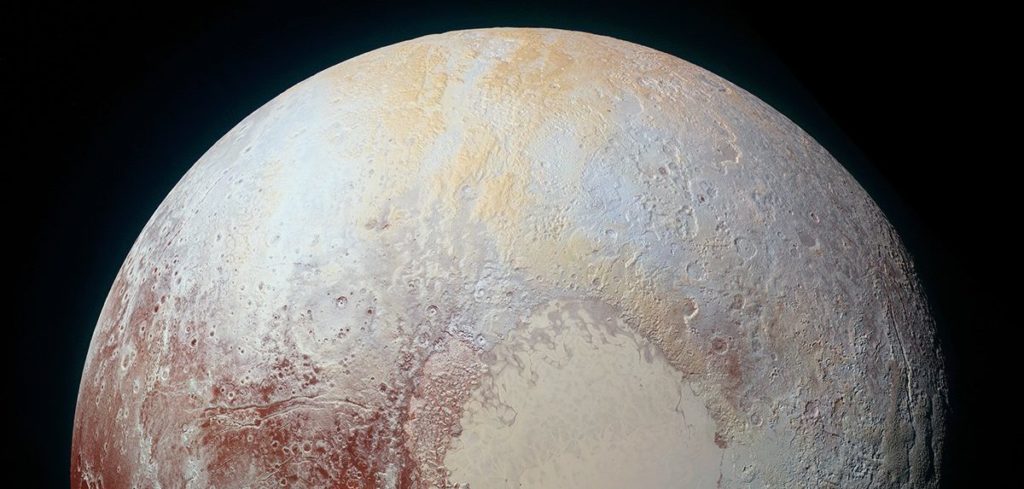
Photo: A color-enhanced photo of Pluto taken by the New Horizons Spacecraft | NASA/JHUAPL/SwRI
Currently, the International Astronomical Union (IAU) officially classifies five celestial bodies in our solar system as dwarf planets: Pluto, Eris, Ceres, Makemake, and Haumea. Dwarf planets are defined as objects that orbit a star (such as our Sun), are roughly spherical in shape,1 and can sometimes have other large bodies such as comets, asteroids, or other dwarf planets orbiting near them. Astronomers have identified many other objects that could be considered for the category, and it’s estimated that hundreds or even thousands more could exist, scattered throughout our solar system.
1 A fancier term for this concept is “hydrostatic equilibrium”!
Pluto
Pluto is widely considered to be the ninth planet in our solar system. The IAU reclassified Pluto as a dwarf planet in 2006, but its planetary status remains a matter of debate. This small, icy world meets all the criteria for a full-fledged planet but one: it isn’t large enough to have gravitational dominance over the celestial bodies around it; in other words, it doesn’t “clear its neighborhood” of objects like asteroids, comets, and other dwarf planets. Pluto is the largest known dwarf planet in our solar system. It has five moons: Charon, Styx, Nix, Kerberos, and Hydra.
Eris
Named for the Greco-Roman goddess of discord, Eris is located just outside of Neptune’s orbit. This small but dense dwarf planet was discovered at Palomar Observatory in 2005. Its striking similarities to Pluto are thought to have played a large role in the eventual reclassification of Pluto’s planetary status. It contains 25% more matter than Pluto, despite being smaller in size. Though Eris has never been directly observed, astronomers have detected the presence of methane ice on its surface, suggesting that its environment is similar to Pluto’s. It takes 557 Earth years for Eris and its single moon Dysnomia to complete a trip around the Sun, and 24.9 hours to complete a rotation.
Ceres
Ceres is the very first dwarf planet to be discovered, though its official classification as such wouldn’t come until 2006. It’s is the largest object in the asteroid belt and accounts for nearly a third of its mass, but is still the smallest known dwarf planet in our solar system. It was discovered by Italian Catholic priest and astronomer Guiseppe Piazzi in 1801, who initially noted the object as a comet since it was “a moving, star-like object.” He named the mysterious object Cerere Ferdinandea, after Ceres, the Roman goddess of agriculture (“Cerere” in Italian), and King Ferdinand of Sicily. However, the Ferdinandea was later dropped due to political reasons. Ceres’s core is thought to consist of ice and rock, with an icy outer crust. It’s the only dwarf planet with no moons.
Makemake
Makemake (pronounced mah-kay-mah-kay) is the second-brightest Kuiper belt object visible from Earth, with Pluto being the first. It was discovered at Palomar Observatory in 2005 and named after the Rapanui god of fertility. Like Eris, its classification as a dwarf planet is thought to have played a large role in the reclassification of Pluto’s planetary status. Very little is know about Makemake’s structure, but scientists have detected the presence of frozen methane and ethane on its surface. It has never been observed at close range, but it appears to be a reddish-brown shade similar to that Pluto. It has one provisional moon, S/2015 (nicknamed MK 2).
Haumea
Last but not least is Haumea, a dwarf planet named after the Hawaiian goddess of childbirth. Days on Haumea are only 4 Earth hours long, but its years are equivalent to 285 Earth years. Because of its unusually fast rotation speed, its shape has become distorted into an oval rather than a sphere. With a radius of 385 miles (620 km), it’s roughly the same size as Pluto. Scientists believe that Haumea is made of rock with an icy outer coating. It has two moons called Namaka and Hi’iaka.
3D models courtesy of NASA Visualization Technology Applications and Development (VTAD)